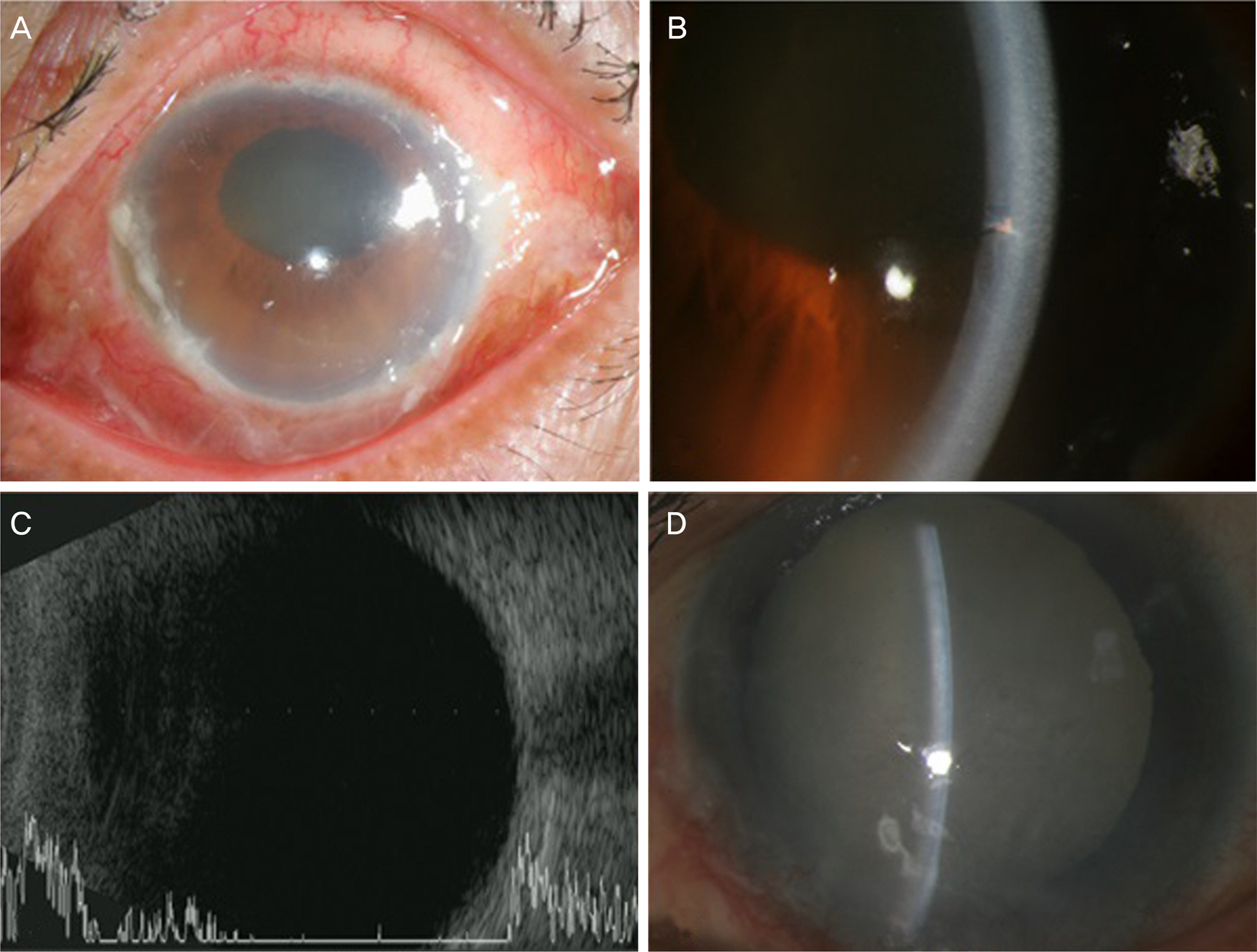J Korean Ophthalmol Soc.
2016 Dec;57(12):1981-1986. 10.3341/jkos.2016.57.12.1981.
Prognosis of Ocular Injury Caused by Wasp Sting: Case Reports
- Affiliations
-
- 1Department of Ophthalmology, Kyung Hee University Hospital at Gangdong, Kyung Hee University School of Medicine, Seoul, Korea. ophmoon@dreamwiz.com
- KMID: 2362720
- DOI: http://doi.org/10.3341/jkos.2016.57.12.1981
Abstract
- PURPOSE
In the present study, the prognosis of ocular injury caused by a wasp sting was evaluated in two cases: Case 1 was treated by anterior chamber irrigation and Case 2 was simultaneously treated by anterior chamber irrigation and vitrectomy.
CASE SUMMARY
Both patients had unilateral damage and complained of severe eye pain and blurred vision. Severe corneal edema, conjunctival injection, marked anterior chamber inflammatory reaction and the wasp sting through the cornea at the anterior chamber were observed in both cases. In Case 1, anterior chamber irrigation was performed, however, corneal edema was not recovered. Six months after the wasp sting, phthisis was observed. In Case 2, anterior chamber irrigation and vitrectomy were simultaneously performed, corneal edema decreased and epithelial healing occurred. Four months after the wasp sting, the eyeball was stable, but there was no wave on the electroretinogram.
CONCLUSIONS
Unlike the ocular damage resulting from a bee sting, the ocular damage from a wasp sting causes severe toxic reactions and results in poor prognosis. Aggressive treatment including vitrectomy is necessary shortly after wasp sting injury to save both the vision and eyeball.
MeSH Terms
Figure
Cited by 1 articles
-
A Report of Two Case of Ocular Toxicity Resulting from Direct or Indirect Bee Venom
Chan Ho Lee, Chang Hwan Lee, Moo Hwan Chang, Young Seung Seo
J Korean Ophthalmol Soc. 2019;60(4):399-405. doi: 10.3341/jkos.2019.60.4.399.
Reference
-
References
1. Vetter RS, Visscher PK, Camazine S. Mass envenomations by honey bees and wasps. West J Med. 1999; 170:223–7.2. Park JK, Chang KC. Corneal endothelial changes induced by abdominal bee sting injury. J Korean Ophthalmol Soc. 2010; 51:435–9.3. Habermann E. Bee and wasp venoms. Science. 1972; 177:314–22.
Article4. Gilboa M, Gdal-On M, Zonis S. Bee and wasp stings of the eye. Retained intralenticular wasp sting: a case report. Br J Ophthalmol. 1977; 61:662–4.
Article5. Arcieri ES, França ET, Oliveria HB, et al. Ocular lesions arising abdominal stings by hymenopteran insects. Cornea. 2002; 21:328–30.6. Teoh SC, Lee JJ, Fam HB. Corneal honeybee sting. Can J Ophthalmol. 2005; 40:469–71.
Article7. Chen CJ, Richardson CD. Bee sting-induced ocular changes. Ann Ophthalmol. 1986; 18:285–6.8. Choe GY, Chi KU. Wasp sting on the eyeball. J Korean Ophthalmol Soc. 1968; 9:39–42.9. Li Z, Oh HJ, Ji Y, Yoon KC. Wasp sting of the cornea: a case treated with amniotic membrane transplantation. Graefes Arch Clin Exp Ophthalmol. 2013; 251:1039–40.
Article10. Lai P, Yang J, Cui H, Xie H. Prognosis of corneal wasp sting: case report and review of the literature. Cutan Ocul Toxicol. 2011; 30:325–7.
Article11. Kim JM, Kang SJ, Kim MK, et al. Corneal wasp sting abdominal by optic neuropathy and retinopathy. Jpn J Ophthalmol. 2011; 55:165–7.12. Lin PH, Wang NK, Hwang YS, et al. Bee Sting of the cornea and conjunctiva: management and outcomes. Cornea. 2011; 30:392–4.
Article13. King TP, Spangfort MD. Structure and biology of stinging insect venom allergens. Int Arch Allergy Immunol. 2000; 123:99–106.
Article14. Smolin G, Wong I. Bee sting of the cornea: case report. Ann Ophthalmol. 1982; 14:342–3.15. George P, Pawar B, Calton N, Mathew P. Wasp sting: an unusual abdominal outcome. Saudi J Kidney Dis Transpl. 2008; 19:969–72.16. Haspel G, Libersat F. Wasp venom blocks central cholinergic syn-apses to induce transient paralysis in cockroach prey. J Neurobiol. 2003; 54:628–37.
Article17. Nakatani Y, Nishimura A, Sugiyama K. Successful treatment of corneal wasp sting-induced panuveitis with vitrectomy. J Ophthalmic Inflamm Infect. 2013; 3:18.
Article18. Yildirim N, Erol N, Basmak H. Bee sting of the cornea: a case report. Cornea. 1998; 17:333–4.19. Al-Towerki AE. Corneal honeybee sting. Cornea. 2003; 22:672–4.
Article20. Razmjoo H, Abtahi MA, Roomizadeh P, et al. Management of abdominal bee sting. Clin Ophthalmol. 2011; 5:1697–700.21. Kitagawa K, Hayasaka S, Setogawa T. Wasp sting-induced retinal damage. Ann Ophthalmol. 1993; 25:157–8.





